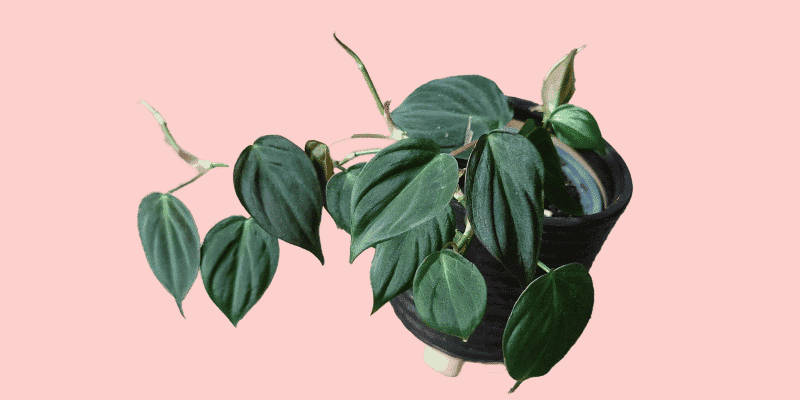Philodendron micans is both easy to care for and easy on the eyes. Its large velvety leaves and trailing vine look fantastic in hanging planters or attached to moss poles.
The most common Philodendron variety, it grows extremely quickly and can make any home look like a small tropical forest.
In this article, I’ll cover everything you need to take care of Philodendron micans, from making stem cuttings for your friends to how to deal with pesky spider mites and yellowing leaves.
Table of Contents
Philodendron Micans Care Guide
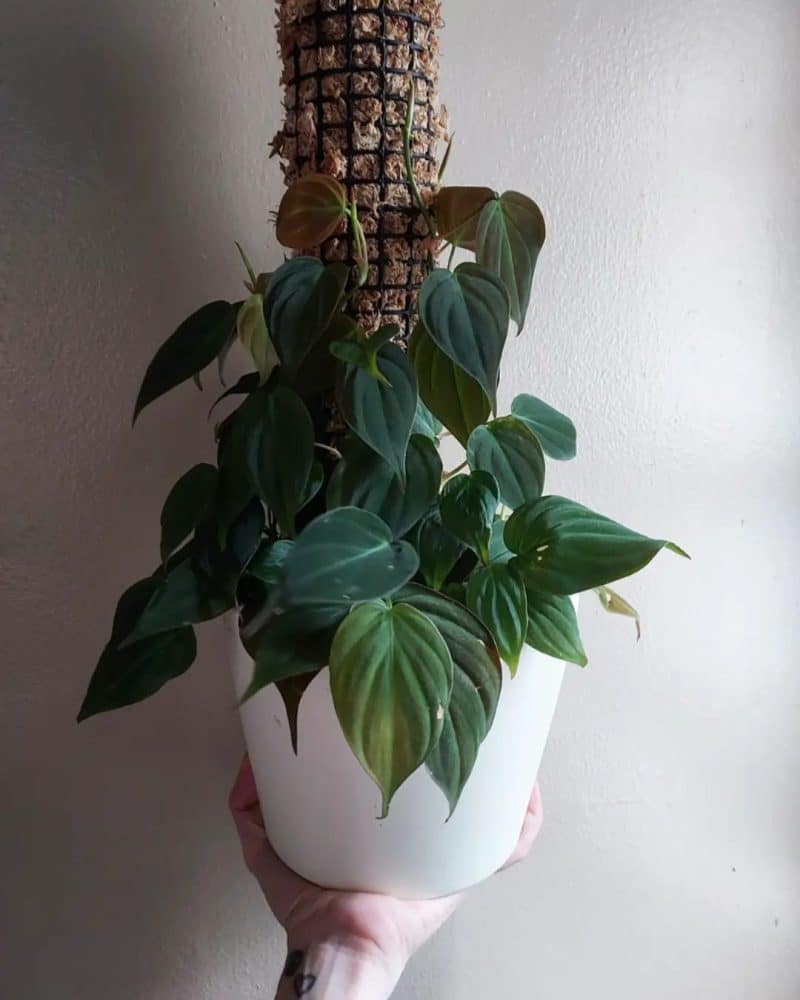
History, habitat, and characteristics
Philodendron micans, also known as the velvet leaf philodendron or the sweetheart plant, is native to the tropical forests of the Caribbean, Mexico, and other Central American countries. Geographically, it’s the most widespread Philodendron type there is (and that’s an achievement, because there are over 560 varietals).
It might also have the longest botanical name of all philodendron plants – Philodendron hederaceum var. hederaceum, try saying that one 10 times fast!
This plant is part of the Araceae family and a variety of the the heart leaf philodendron, instantly recognizable for its velvety, heart-shaped leaves, maroon hues, and trailing growth. As the Philodendron micans matures, its vines thicken, its pinkish-purple coloring disappears, and its texture becomes less velvety.
Philodendron micans has had 20 different name changes since it was discovered in 1760 because its appearance changes so much as it grows that botanists often mistake it for a different plant.
One thing stays the same: it can grow up to one foot tall and two feet wide inside. During the growing season, its vines can grow up to 10 centimeters each week and over three feet total when attached to a moss pole (thanks, aerial roots). All that to say, give this plant room to expand!
These guys are real knockouts in a hanging basket or twining upwards along a pole, and best of all, they’re super easy to care for. How easy? I’ll let you know the ideal lighting, water, soil, temperature, and humidity conditions for the Philodendron micans next.
Lighting
Philodendron micans care isn’t too complicated for an indoor plant.
While this plant can grow in a wide range of light condition it’ll thrive best in medium to bright indirect light. Philodendron micans leaves react to the amount of light in their environment. The more light your plant gets, the bigger its leaves will grow and the deeper shade of maroon they will turn. Less light, and the leaves will grow smaller and achieve a deep green hue.
Don’t put your plant in direct sunlight, since this can burn its delicate leaves. If you find that your plant leaves are discolored and crispy, try placing a sheer curtain over the window to diffuse the light.
Not sure where to place your Philodendron micans for optimal lighting? I suggest a north-facing window, which gets indirect light, or an east-facing one, which gets a bit of direct light in the morning and then indirect for the remainder of the day. These locations help mimic the natural light it gets under forest canopies in the wild.
If you’re trying to grow vines along the floor, make sure your plant has extra light so it doesn’t become leggy or stemmy. You’ll know it needs more light when there is more stem space between leaves as the plant etiolates, or reaches for a light source.
Water
This part isn’t tricky – Philodendron micans likes evenly moist soil, which means watering it thoroughly each time until water drips from the planter’s drainage holes. This plant doesn’t like to be overwatered (every day, for instance), which can cause root rot.
The Philodendron micans is generally forgiving, though, so as long as its roots aren’t constantly waterlogged, it should be fine. Just check to make sure it needs water before you get out the watering can:
- Dip a finger two to three inches into the soil. If it’s dry, time to water.
- Check its leaves. If they begin to droop and curl in a bit, watering time.
- Observe the soil. If it starts to contract and move inwards from the sides of its planter, that’s a sign that it’s becoming too dry.
Okay, great, but just how often does the velvet-leaf philodendron need to be watered? That’s always going to depend on its location and the season. If you’re in a hotter climate receiving more light, you’ll need to water it more than if it’s in a darker, cooler location.
Philodendron micans needs a regular watering schedule in the spring and summer months. In the winter months, you can let it dry out in between waterings.
Temperature and humidity
Although Philodendron micans likes the same household temperatures you probably do, it prefers USDA Zones 10a, 10b, 11a, and 11b, and will grow more quickly in higher temperatures of 68°F-78°F. This plant can tolerate as low as 59°F without wilting, but will grow more slowly in lower temperatures.
You’ll definitely want to avoid placing it near a drafty window or vent in winter, since the cold may stunt its growth. You’ll know the temperature is too low for your plant when its leaves start to turn light brown (you’ll probably also feel a bit chilly!).
The same goes for humidity – the velvet leaf Philodendron micans can tolerate lower levels, but will thrive and grow bigger leaves in 45-50% humidity. To add more humidity to your plant’s environment:
- Place it on a tray with pebbles and water
- Mist its leaves with water from a spray bottle
- Use a humidifier
Soil
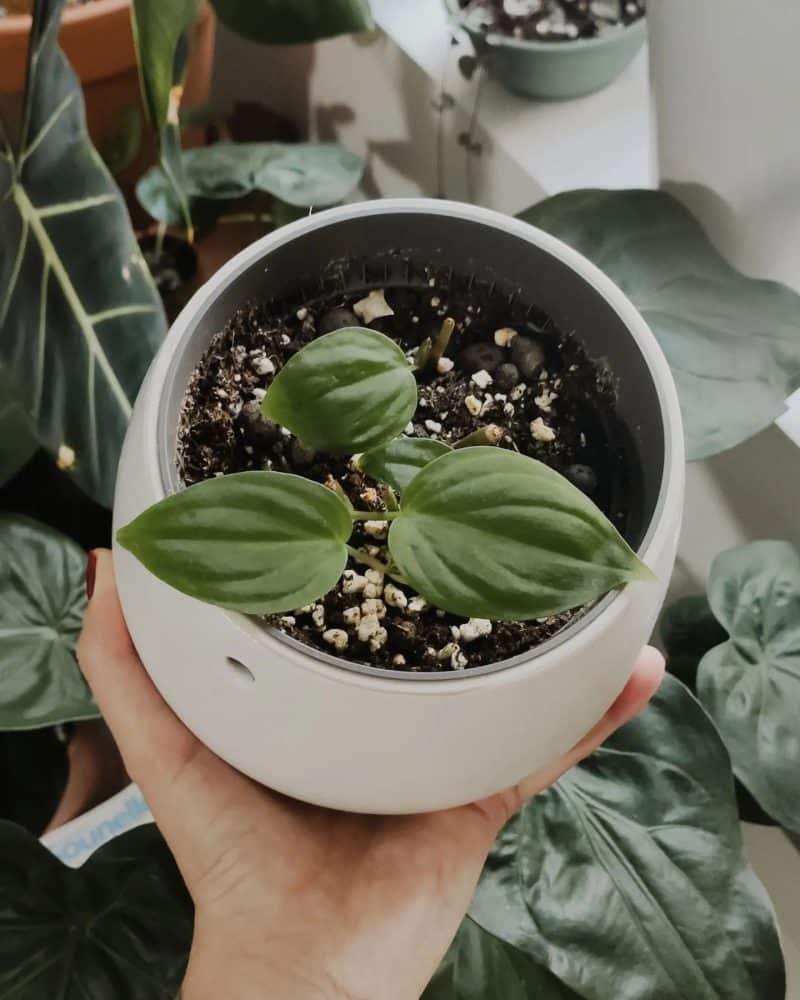
Your Philodendron micans needs moist, well-draining soil that breathes. As a tropical plant, it prefers a more acidic soil pH of 5.0 to 6.5. You can use standard potting soil, but it will really flourish in a custom mix with lots of organic matter. I recommend this one:
- 25% potting soil
- 25% orchid bark
- 25% perlite
- 25% peat moss or coco coir (hairy coconut husk fiber)
- Optional: Vermicast, or worm castings, to aid with soil aeration
Lightly fertilize this plant in the spring and summer growing months with a balanced all-purpose liquid fertilizer to help encourage its growth. (If your soil already has fertilizer additives in it, which will be evident from the package it comes in, this step is unnecessary). In winter, stop fertilizing entirely.
The best type of fertilizer contains what I like to call the Big 3 nutrients – nitrogen for leaf growth, and potassium and phosphorous for root and stem health. Bottle labels will indicate this combination with 5-5-5 or NPK.
If you have LECA (full guide available here), you can also distribute some within the soil: LECA works like a bunch of tiny water sponges that will release water into the soil as it dries out.
Growth and repotting
Philodendron micans are fast growers. They could outgrow their pot in a year or sooner, depending on temperature and humidity levels.
You’ll know when it’s time to repot when the plant is rootbound, which means its roots are curling around themselves inside the soil into a root ball, or pushing out of the top of the soil or bottom via the drainage holes. You might also notice it growing less quickly with smaller leaves, even when nothing about its environment has changed.
When you repot your plants, make sure you choose a pot that’s only two or three inches bigger than its current one to prevent your plant from drowning in too much wet soil and getting root rot. Like all plants, the Philodendron micans requires a pot with a good drainage hole.
Pruning
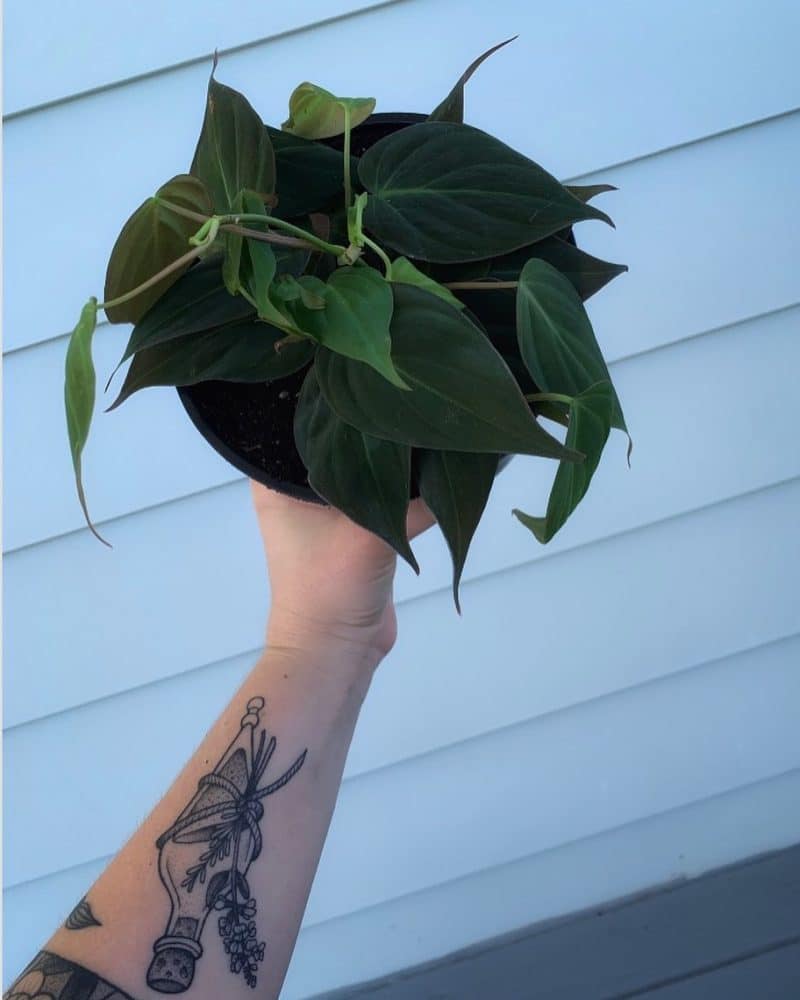
Pruning your Philodendron micans regularly encourages stem branching from each cut, preventing it from becoming leggy. If you don’t prune this plant, it will have one long stem and look less full. Prune it in the spring and summer months during its active growth period by making a clean cut right below the node (where a leaf is attached) with sterilized pruning shears. That’s it!
Pro tip: Any stem cuttings can be used for propagation, so save them if you want to increase your heart leaf philodendron collection.
Okay, let’s get into propagating Philodendron micans.
Propagation guide
Philodendron micans propagation works via stem cutting in water and soil.
Follow these steps to propagate your plant in water:
- Use a sharp, sterilized implement like pruning shears or scissors to make stem cuttings with 4 or 5 leaves or nodes attached each.
- Remove the bottom two leaves on each cutting so the nodes are exposed. If propagating in water, fill a jar with room temperature water and place the cuttings in. Only the stem and nodes should be underwater, not the leaves.
- Place the cuttings in a location that gets medium to bright indirect light.
- Change the water once a week to prevent bacteria buildup.
- After several weeks, you should see root development. When roots grow to be one inch or longer, you can put the cuttings in soil. Moisten the soil first, create a hole with your finger, and then gently cover the roots.
- Keep the soil moist for the first one or two weeks so the cuttings can adjust, but don’t waterlog it. After that, you can water your plant on a normal schedule.
Note that if propagating in soil, the method is the same except you’ll bury the cuttings in soil right away instead of putting them in water first.
Pro tip: Water roots can make the transition between water to soil difficult. This part is optional, but if you find your cutting wilting and losing leaves after being transplanted from water to soil, you ease it into its new environment in two ways:
- Spaghnum moss. Place the cuttings in a clear container with a lid, wrapping the nodes in moist spaghnum moss (peat moss will not work). Close the lid but open it daily for a few minutes to prevent mold. Keep the plant in moss for a month before you transition it to soil.
- Soil/water combo. Alternately, remove half of the water and add soil in a 2:1 ratio (water to soil) for a month before moving your cutting to a soil-filled pot.
Let’s move on to the most common issues and pesky pests your Philodendron micans plant might experience, and how to stop them in their tracks.
Common issues
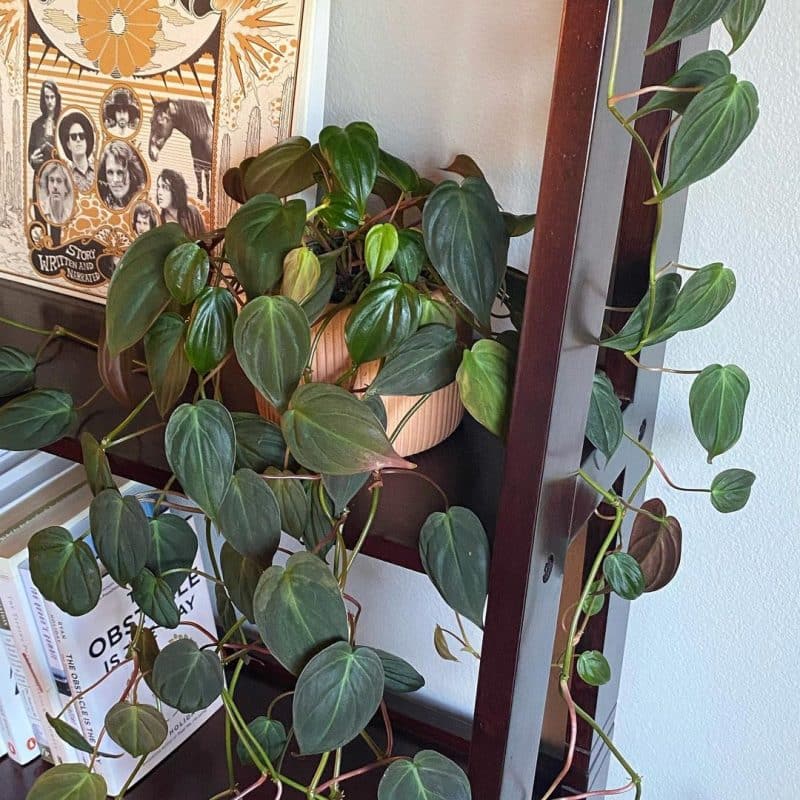
Philodendron micans care isn’t much different than most indoor plants. Most problems stem (pun very much intended) from over or underwatering, poor drainage, or wonky light levels.
- Yellow, limp, or pale leaves. This is either a light or a water issue – too much or too little of either. Test with a finger to make sure the soil is draining and not waterlogged, and make sure your plant is receiving only medium to bright indirect sunlight. More than three hours of direct sun will cause scorching and color fading.
- Curling leaves or mushy stems. This is usually a sign of overwatering or retaining too much moisture in the soil. Make sure soil is loamy and well-draining and that your pot has adequate draining holes. If water isn’t an issue, check the roots to make sure they’re not rotted or too dry.
- Brown leaves. Brown edges can be caused by too little humidity, too much direct light, or overfertilizing. Adjust your plant’s environment accordingly. If you suspect too much fertilizer, flush the soil with water to clear it out.
- Leggy stems/small leaves. Your plant has undesirably low light levels, you aren’t pruning it regularly, or it may need more fertilizer (if you aren’t giving it any during the growing months). Move your Philodendron micans closer to a light source or consider using a grow or LED light. Prune it when stems get particularly long to encourage branching.
- Leaf loss. Older leaves tend to fall off as the plant grows, but if new leaves are falling off or your plant is suddenly losing many at once, you need to water it more. Ensure it isn’t drying out too much between waterings in the growing season.
Diseases and pests
Root rot. Like many tropical plants, Philodendron micans can develop root rot if overwatered. Only water it when the soil is dry to the touch several inches down.
Common pests. Philodendron micans are more prone to spider mite infestations. Like other umbrella plants, they can also be affected by scale (small, flat, oval insects with a tan or brown shell that leave a sticky residue). Aphids, mealybugs, and fungus gnats can also come out to play.
I prefer neem oil to insecticidal soap to kill off any spider mites or other common houseplant pests. Prune the infested locations first, then spray the tops and undersides of leaves and all around stems (if using pure neem oil, dilute it with 50% water first).
Conclusion
Philodendron micans is a tropical plant that thrives in medium to bright indirect light, moderate to high humidity, and regular household temperatures. Its leaves will grow larger and more quickly with temperature and humidity on the higher end of the spectrum.
This fast grower looks gorgeous spreading out along the ground or vining around moss poles. Give it a personalized soil mix that drains well and lets its roots breathe. Propagate your Philodendron micans via stem cutting in soil or water to create a collection, and soon you’ll feel like you’re in the tropics.
FAQ
Where can I buy Philodendron micans?
Philodendron micans (just like the Philodendron gloriosum or birkin plant) aren’t hard to find – you can pick this plant up at your local nursery or gardening store.
Does a Philodendron micans need regular pruning?
Velvet leaf philodendron plants need regular pruning if you want them to grow full foliage with many branches. Otherwise, you’ll have one long stem with fewer leaves.
Is Philodendron micans a climbing plant? Does it need a pole?
A trailing plant, Philodendron micans loves to climb. You can grow it along the floor (just make sure it gets enough light so it doesn’t get leggy) or make use of the plant’s aerial root and train it along a moss pole.
Tip: These guys are fast growers, so if your plant outgrows its pole, try using a trellis or training it around a wall with command hooks.
What is the difference between Philodendron melanochrysum and micans?
This video does a great job explaining the differences between the two varietals. Basically, while they are similar plants, Philodendron micans vines, while melanochrysum climbs, or grows upwards naturally. The melanochrysum also has wide whitish or cream-colored margins.

